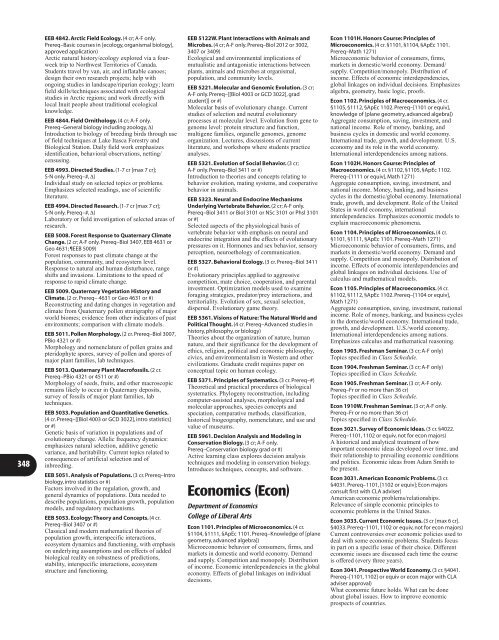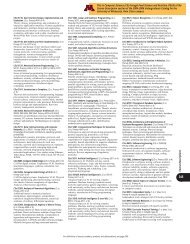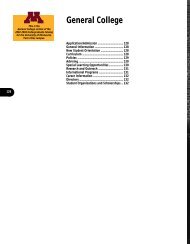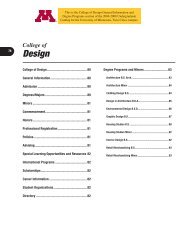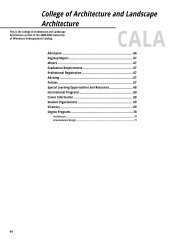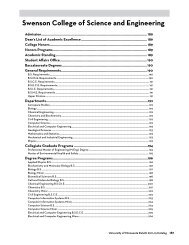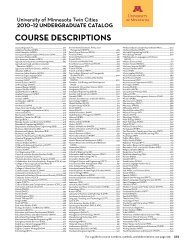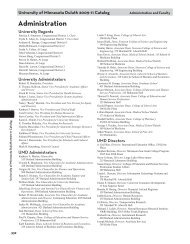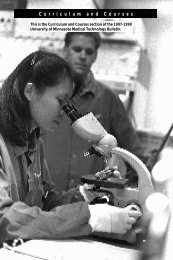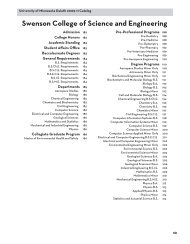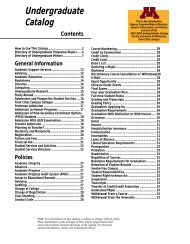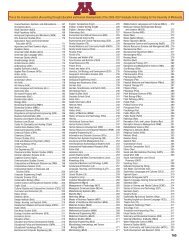CoursesâA through G and course numbers and symbols key
CoursesâA through G and course numbers and symbols key
CoursesâA through G and course numbers and symbols key
- No tags were found...
You also want an ePaper? Increase the reach of your titles
YUMPU automatically turns print PDFs into web optimized ePapers that Google loves.
348EEB 4842. Arctic Field Ecology. (4 cr; A-F only.Prereq–Basic <strong>course</strong>s in [ecology, organismal biology],approved application)Arctic natural history/ecology explored via a fourweektrip to Northwest Territories of Canada.Students travel by van, air, <strong>and</strong> inflatable canoes;design their own research projects; help withongoing studies in l<strong>and</strong>scape/riparian ecology; learnfield skills/techniques associated with ecologicalstudies in Arctic regions; <strong>and</strong> work directly withlocal Inuit people about traditional ecologicalknowledge.EEB 4844. Field Ornithology. (4 cr; A-F only.Prereq–General biology including zoology, ∆)Introduction to biology of breeding birds <strong>through</strong> useof field techniques at Lake Itasca Forestry <strong>and</strong>Biological Station. Daily field work emphasizesidentification, behavioral observations, netting/censusing.EEB 4993. Directed Studies. (1-7 cr [max 7 cr];S-N only. Prereq–#, ∆)Individual study on selected topics or problems.Emphasizes selected readings, use of scientificliterature.EEB 4994. Directed Research. (1-7 cr [max 7 cr];S-N only. Prereq–#, ∆)Laboratory or field investigation of selected areas ofresearch.EEB 5008. Forest Response to Quaternary ClimateChange. (2 cr; A-F only. Prereq–Biol 3407, EEB 4631 orGeo 4631; EEB 5009)Forest responses to past climate change at thepopulation, community, <strong>and</strong> ecosystem level.Response to natural <strong>and</strong> human disturbance, rangeshifts <strong>and</strong> invasions. Limitations to the speed ofresponse to rapid climate change.EEB 5009. Quaternary Vegetation History <strong>and</strong>Climate. (2 cr. Prereq– 4631 or Geo 4631 or #)Reconstructing <strong>and</strong> dating changes in vegetation <strong>and</strong>climate from Quaternary pollen stratigraphy of majorworld biomes; evidence from other indicators of pastenvironments; comparison with climate models.EEB 5011. Pollen Morphology. (2 cr. Prereq–Biol 3007,PBio 4321 or #)Morphology <strong>and</strong> nomenclature of pollen grains <strong>and</strong>pteridophyte spores, survey of pollen <strong>and</strong> spores ofmajor plant families, lab techniques.EEB 5013. Quaternary Plant Macrofossils. (2 cr.Prereq–PBio 4321 or 4511 or #)Morphology of seeds, fruits, <strong>and</strong> other macroscopicremains likely to occur in Quaternary deposits,survey of fossils of major plant families, labtechniques.EEB 5033. Population <strong>and</strong> Quantitative Genetics.(4 cr. Prereq–[[Biol 4003 or GCD 3022], intro statistics]or #)Genetic basis of variation in populations <strong>and</strong> ofevolutionary change. Allelic frequency dynamics:emphasizes natural selection, additive geneticvariance, <strong>and</strong> heritability. Current topics related toconsequences of artificial selection <strong>and</strong> ofinbreeding.EEB 5051. Analysis of Populations. (3 cr. Prereq–Introbiology, intro statistics or #)Factors involved in the regulation, growth, <strong>and</strong>general dynamics of populations. Data needed todescribe populations, population growth, populationmodels, <strong>and</strong> regulatory mechanisms.EEB 5053. Ecology: Theory <strong>and</strong> Concepts. (4 cr.Prereq–Biol 3407 or #)Classical <strong>and</strong> modern mathematical theories ofpopulation growth, interspecific interactions,ecosystem dynamics <strong>and</strong> functioning, with emphasison underlying assumptions <strong>and</strong> on effects of addedbiological reality on robustness of predictions,stability, interspecific interactions, ecosystemstructure <strong>and</strong> functioning.EEB 5122W. Plant Interactions with Animals <strong>and</strong>Microbes. (4 cr; A-F only. Prereq–Biol 2012 or 3002,3407 or 3409)Ecological <strong>and</strong> environmental implications ofmutualistic <strong>and</strong> antagonistic interactions betweenplants, animals <strong>and</strong> microbes at organismal,population, <strong>and</strong> community levels.EEB 5221. Molecular <strong>and</strong> Genomic Evolution. (3 cr;A-F only. Prereq–[[Biol 4003 or GCD 3022], gradstudent]] or #)Molecular basis of evolutionary change. Currentstudies of selection <strong>and</strong> neutral evolutionaryprocesses at molecular level. Evolution from gene togenome level: protein structure <strong>and</strong> function,multigene families, organelle genomes, genomeorganization. Lectures, discussions of currentliterature, <strong>and</strong> workshops where students practiceanalyses.EEB 5321. Evolution of Social Behavior. (3 cr;A-F only. Prereq–Biol 3411 or #)Introduction to theories <strong>and</strong> concepts relating tobehavior evolution, mating systems, <strong>and</strong> cooperativebehavior in animals.EEB 5323. Neural <strong>and</strong> Endocrine MechanismsUnderlying Vertebrate Behavior. (2 cr; A-F only.Prereq–Biol 3411 or Biol 3101 or NSc 3101 or Phsl 3101or #)Selected aspects of the physiological basis ofvertebrate behavior with emphasis on neural <strong>and</strong>endocrine integration <strong>and</strong> the effects of evolutionarypressures on it. Hormones <strong>and</strong> sex behavior, sensoryperception, neuroethology of communication.EEB 5327. Behavioral Ecology. (3 cr. Prereq–Biol 3411or #)Evolutionary principles applied to aggressivecompetition, mate choice, cooperation, <strong>and</strong> parentalinvestment. Optimization models used to examineforaging strategies, predator/prey interactions, <strong>and</strong>territoriality. Evolution of sex, sexual selection,dispersal. Evolutionary game theory.EEB 5361. Visions of Nature: The Natural World <strong>and</strong>Political Thought. (4 cr. Prereq–Advanced studies inhistory, philosophy, or biology)Theories about the organization of nature, humannature, <strong>and</strong> their significance for the development ofethics, religion, political <strong>and</strong> economic philosophy,civics, <strong>and</strong> environmentalism in Western <strong>and</strong> othercivilizations. Graduate credit requires paper onconceptual topic on human ecology.EEB 5371. Principles of Systematics. (3 cr. Prereq–#)Theoretical <strong>and</strong> practical procedures of biologicalsystematics. Phylogeny reconstruction, includingcomputer-assisted analyses, morphological <strong>and</strong>molecular approaches, species concepts <strong>and</strong>speciation, comparative methods, classification,historical biogeography, nomenclature, <strong>and</strong> use <strong>and</strong>value of museums.EEB 5961. Decision Analysis <strong>and</strong> Modeling inConservation Biology. (3 cr; A-F only.Prereq–Conservation biology grad or #)Active learning class explores decision analysistechniques <strong>and</strong> modeling in conservation biology.Introduces techniques, concepts, <strong>and</strong> software.Economics (Econ)Department of EconomicsCollege of Liberal ArtsEcon 1101. Principles of Microeconomics. (4 cr.§1104, §1111, §ApEc 1101. Prereq–Knowledge of [planegeometry, advanced algebra])Microeconomic behavior of consumers, firms, <strong>and</strong>markets in domestic <strong>and</strong> world economy. Dem<strong>and</strong><strong>and</strong> supply. Competition <strong>and</strong> monopoly. Distributionof income. Economic interdependencies in the globaleconomy. Effects of global linkages on individualdecisions.Econ 1101H. Honors Course: Principles ofMicroeconomics. (4 cr. §1101, §1104, §ApEc 1101.Prereq–Math 1271)Microeconomic behavior of consumers, firms,markets in domestic/world economy. Dem<strong>and</strong>/supply. Competition/monopoly. Distribution ofincome. Effects of economic interdependencies,global linkages on individual decisions. Emphasizesalgebra, geometry, basic logic, proofs.Econ 1102. Principles of Macroeconomics. (4 cr.§1105, §1112, §ApEc 1102. Prereq–[1101 or equiv],knowledge of [plane geometry, advanced algebra])Aggregate consumption, saving, investment, <strong>and</strong>national income. Role of money, banking, <strong>and</strong>business cycles in domestic <strong>and</strong> world economy.International trade, growth, <strong>and</strong> development. U.S.economy <strong>and</strong> its role in the world economy.International interdependencies among nations.Econ 1102H. Honors Course: Principles ofMacroeconomics. (4 cr. §1102, §1105, §ApEc 1102.Prereq–[1111 or equiv], Math 1271)Aggregate consumption, saving, investment, <strong>and</strong>national income. Money, banking, <strong>and</strong> businesscycles in the domestic/global economy. Internationaltrade, growth, <strong>and</strong> development. Role of the UnitedStates in world economy, internationalinterdependencies. Emphasizes economic models toexplain macroeconomic phenomena.Econ 1104. Principles of Microeconomics. (4 cr.§1101, §1111, §ApEc 1101. Prereq–Math 1271)Microeconomic behavior of consumers, firms, <strong>and</strong>markets in domestic/world economy. Dem<strong>and</strong> <strong>and</strong>supply. Competition <strong>and</strong> monopoly. Distribution ofincome. Effects of economic interdependencies <strong>and</strong>global linkages on individual decisions. Use ofcalculus <strong>and</strong> mathematical models.Econ 1105. Principles of Macroeconomics. (4 cr.§1102, §1112, §ApEc 1102. Prereq–[1104 or equiv],Math 1271)Aggregate consumption, saving, investment, nationalincome. Role of money, banking, <strong>and</strong> business cyclesin the domestic/world economy. International trade,growth, <strong>and</strong> development. U.S./world economy.International interdependencies among nations.Emphasizes calculus <strong>and</strong> mathematical reasoning.Econ 1903. Freshman Seminar. (3 cr; A-F only)Topics specified in Class Schedule.Econ 1904. Freshman Seminar. (3 cr; A-F only)Topics specified in Class Schedule.Econ 1905. Freshman Seminar. (3 cr; A-F only.Prereq–Fr or no more than 36 cr)Topics specified in Class Schedule.Econ 1910W. Freshman Seminar. (3 cr; A-F only.Prereq–Fr or no more than 36 cr)Topics specified in Class Schedule.Econ 3021. Survey of Economic Ideas. (3 cr. §4022.Prereq–1101, 1102 or equiv, not for econ majors)A historical <strong>and</strong> analytical treatment of howimportant economic ideas developed over time, <strong>and</strong>their relationship to prevailing economic conditions<strong>and</strong> politics. Economic ideas from Adam Smith tothe present.Econ 3031. American Economic Problems. (3 cr.§4031. Prereq–1101, [1102 or equiv]; Econ majorsconsult first with CLA adviser)American economic problems/relationships.Relevance of simple economic principles toeconomic problems in the United States.Econ 3033. Current Economic Issues. (3 cr [max 6 cr].§4033. Prereq–1101, 1102 or equiv, not for econ majors)Current controversies over economic policies used todeal with some economic problems. Students focusin part on a specific issue of their choice. Differenteconomic issues are discussed each time the <strong>course</strong>is offered (every three years).Econ 3041. Prospective World Economy. (3 cr. §4041.Prereq–[1101, 1102] or equiv or econ major with CLAadviser approval)What economic future holds. What can be doneabout global issues. How to improve economicprospects of countries.


